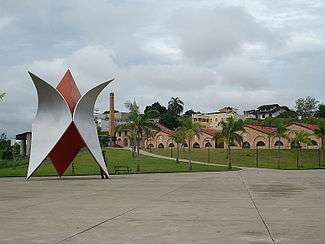Registro
Registro is in the South Coast region of São Paulo. The largest city of the Ribeira Valley, one of the poorest regions of the state, Registro contains a valuable Japanese heritage.

Understand
Registro, as much as the rest of the Ribeira Valley, was settled in the XVII as a gold mining community, but prosperity didn't last long. In the beginning of the twentieth century, the region gained new life with the arrival of thousands of Japanese immigrants, brought by the Kaigai Kogyo Kabushiki Kaisha (KKKK) company, and who started cultivating rice and tea in the region.
The municipality of Registro was created in 1944. Agriculture remains important to the city's economy, and it is also a center of services of the Ribeira Valley. If there is a major attraction in Registro, it is the cultural heritage left by one of the earliest waves of Japanese immigrants to Brazil.
Get in
Get around
See
- KKKK Education and Culture Center (Casarão do Porto, Centro de Educação e Cultura KKKK), R. Seiji Sumida. Historical warehouse constructed between 1913-1918 by the KKKK (Kaigai Kogyo Kabushiki Kaisha) company, which brought early Japanese colonizers to Registro. Nowadays it contains the Ribeira Valley Japanese Immigration Memorial (Memorial da Imigração Japonesa Vale do Ribeira), with exhibits of tools, clothes, maps, documents, and farm implements.
- Igreja de Todos os Santos, Bairro Manga Larga. Easily mistaken by a Buddhist temple, it is actually an Anglican church, built in 1929 by Japanese from the Nagano prefecture. It is a national heritage construction.
- Praça Beira Rio, Parque Prefeito José de Carvalho. Pleasant spot located next to the Ribeira river and the KKKK. It contains the Guaracuí, a sculpture of a tulip made of steel by the renowned Japanese artist Tomie Ohtake.
- Honpa Hongwanji Buddhist temple, Avenida Estados Unidos, 50, ☎ +55 13 3821-1998. A small but charming Shin Buddhist temple constructed in 1967.
- Praça dos Expedicionários.
- Torazo Okamoto Municipal Woods (Bosque Municipal Torazo Okamoto).
- Nakatsugawa City Square (Praça Cidade de Nakatsugawa). This square has Japanese-style architecture reminiscent of the town's sister city of Nakatsugawa, in Japan.
- Bunkyo Registro, Rua Nakatsugawa, 165. The building of the Japanese Cultural Association of Registro is a beautiful example of Japanese architecture.
Do
- Tooro Nagashi. A truly Japanese-Brazilian ceremony, Registro's Tooro Nagashi is similar to the Japanese event of same name, but it's celebrated instead on 2 November (Catholic All Saints' Day). In this ceremony, a couple of thousand paper lanterns are released into the Ribeira river.
Buy
Typical products from Registro include mats, bags and sandals made of beak-sedge, brought in 1933 by Japanese immigrants and currently cultivated only in Registro and in Sete Barras.
Eat
Drink
Sleep
Connect
Go next
| Routes through Registro |
| Curitiba ← Pariquera-Açu ← | S |
→ Juquiá → São Paulo |